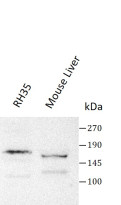ARG10766
anti-ABCB4 / MDR3 antibody
anti-ABCB4 / MDR3 antibody for Flow cytometry,Western blot and Human,Mouse,Rat
Overview
| Product Description | Rabbit polyclonal antibody recognizes ABCB4 / MDR3 |
|---|---|
| Tested Reactivity | Hu, Ms, Rat |
| Tested Application | FACS, WB |
| Host | Rabbit |
| Clonality | Polyclonal |
| Isotype | IgG |
| Target Name | ABCB4 / MDR3 |
| Antigen Species | Human |
| Immunogen | Partial recombinant protein around aa. 601-720 of Human ABCB4 / MDR3. |
| Conjugation | Un-conjugated |
| Alternate Names | ATP-binding cassette sub-family B member 4; P-glycoprotein 3; ABC21; PGY3; MDR3; MDR2; MDR2/3; Multidrug resistance protein 3; EC 3.6.3.44; PFIC-3; GBD1; ICP3 |
Application Instructions
| Application Suggestion |
|
||||||
|---|---|---|---|---|---|---|---|
| Application Note | * The dilutions indicate recommended starting dilutions and the optimal dilutions or concentrations should be determined by the scientist. |
Properties
| Form | Liquid |
|---|---|
| Purification | Affinity purification with immunogen. |
| Buffer | PBS, 0.025% Sodium azide and 2.5% BSA. |
| Preservative | 0.025% Sodium azide |
| Stabilizer | 2.5% BSA |
| Concentration | 0.5 mg/ml |
| Storage Instruction | For continuous use, store undiluted antibody at 2-8°C for up to a week. For long-term storage, aliquot and store at -20°C or below. Storage in frost free freezers is not recommended. Avoid repeated freeze/thaw cycles. Suggest spin the vial prior to opening. The antibody solution should be gently mixed before use. |
| Note | For laboratory research only, not for drug, diagnostic or other use. |
Bioinformation
| Database Links | |
|---|---|
| Gene Symbol | ABCB4 |
| Gene Full Name | ATP-binding cassette, sub-family B (MDR/TAP), member 4 |
| Background | The membrane-associated protein encoded by this gene is a member of the superfamily of ATP-binding cassette (ABC) transporters. ABC proteins transport various molecules across extra- and intra-cellular membranes. ABC genes are divided into seven distinct subfamilies (ABC1, MDR/TAP, MRP, ALD, OABP, GCN20, White). This protein is a member of the MDR/TAP subfamily. Members of the MDR/TAP subfamily are involved in multidrug resistance as well as antigen presentation. This gene encodes a full transporter and member of the p-glycoprotein family of membrane proteins with phosphatidylcholine as its substrate. The function of this protein has not yet been determined; however, it may involve transport of phospholipids from liver hepatocytes into bile. Alternative splicing of this gene results in several products of undetermined function. [provided by RefSeq, Jul 2008] |
| Function | Mediates ATP-dependent export of organic anions and drugs from the cytoplasm. Hydrolyzes ATP with low efficiency. Not capable of conferring drug resistance. Mediates the translocation of phosphatidylcholine across the canalicular membrane of the hepatocyte. [UniProt] |
| Calculated MW | 142 kDa |
| PTM | Phosphorylated (PubMed:24723470). Phosphorylation on Thr-34 is required for PC efflux activity. Phosphorylation occurs on serine and threonine residues in a protein kinase A- or C-dependent manner (PubMed:24723470). May be phosphorylated on Thr-44 and Ser-49 (PubMed:24723470). Glycosylated (PubMed:17523162, PubMed:24723470, PubMed:21820390). |
Images (2) Click the Picture to Zoom In
-
ARG10766 anti-ABCB4 / MDR3 antibody WB image
Western blot:RH35 and Mouse liver tissue stained with ARG10766 anti-ABCB4 / MDR3 antibody.
-
ARG10766 anti-ABCB4 / MDR3 antibody FACS image
Flow Cytometry: HepG2 cells were blocked with 10% normal goat serum and then stained with ARG10766 anti-ABCB4 / MDR3 antibody (blue) at 1 µg/10^6 cells for 30 min at 20°C, followed by incubation with DyLight®488 labelled secondary antibody. Isotype control antibody (green) was rabbit IgG (1 µg/10^6 cells) used under the same conditions. Unlabelled sample (red) was also used as a control.







